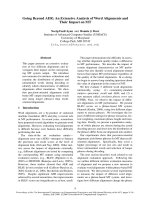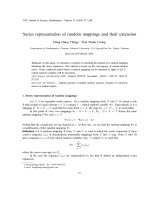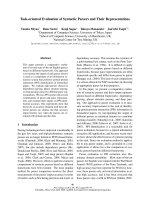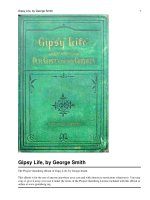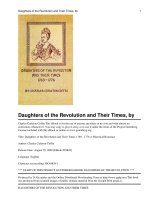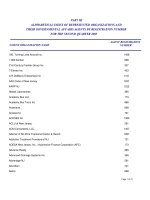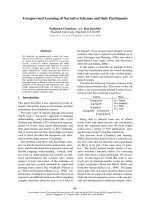Multimodal alignment of scholarly documents and their presentations
Bạn đang xem bản rút gọn của tài liệu. Xem và tải ngay bản đầy đủ của tài liệu tại đây (1.41 MB, 63 trang )
Multimodal Alignment of Scholarly Documents
and Their Presentations
Bamdad Bahrani
(B.Eng, Amirkabir University of Technology)
Submitted in partial fulfillment of the
requirements for the degree
of Master of Science
in the School of Computing
NATIONAL UNIVERSITY OF SINGAPORE
2013
Declaration
I hereby declare that this thesis is my original work and it has been written by me
in its entirety. I have duly acknowledged all the sources of information which have
been used in the thesis. This thesis has also not been submitted for any degree in
any university previously.
Bamdad Bahrani
03/28/2013
To my parents, without whom, it was not possible for me to improve...
iii
Acknowledgments
I would like to thank my supervisor Dr. Kan Min-Yen for his invaluable
guidance through the rout of my graduate education.
iv
Contents
List of Figures
iii
List of Tables
v
Chapter 1 Introduction
1
1.1
Motivation . . . . . . . . . . . . . . . . . . . . . . . . . . . . . . . .
2
1.2
Problem Definition . . . . . . . . . . . . . . . . . . . . . . . . . . .
3
1.3
Solution . . . . . . . . . . . . . . . . . . . . . . . . . . . . . . . . .
4
1.4
Organization
5
. . . . . . . . . . . . . . . . . . . . . . . . . . . . . .
Chapter 2 Related Work
6
2.1
Presentation Processing . . . . . . . . . . . . . . . . . . . . . . . .
6
2.2
Text alignment and Similarity measures . . . . . . . . . . . . . . . .
10
2.3
Synthetic Image Classification . . . . . . . . . . . . . . . . . . . . .
13
Chapter 3 Slide Analysis
17
3.1
Slide Categorization and Statistics
. . . . . . . . . . . . . . . . . .
18
3.2
Baseline Error Analysis . . . . . . . . . . . . . . . . . . . . . . . . .
21
Chapter 4 Method
4.1
23
Preprocessing . . . . . . . . . . . . . . . . . . . . . . . . . . . . . .
24
4.1.1
25
Text Extraction . . . . . . . . . . . . . . . . . . . . . . . . .
i
4.1.1.1
Paper Text Extraction . . . . . . . . . . . . . . . .
25
4.1.1.2
Slide Text Extraction . . . . . . . . . . . . . . . .
26
POS Tagging, Stemming, Noise removal . . . . . . . . . . .
26
Image Classification . . . . . . . . . . . . . . . . . . . . . . . . . . .
27
4.2.1
Classifier Design . . . . . . . . . . . . . . . . . . . . . . . .
29
4.2.2
Image Classification Results . . . . . . . . . . . . . . . . . .
30
Multimodal Alignment . . . . . . . . . . . . . . . . . . . . . . . . .
31
4.3.1
Text Alignment . . . . . . . . . . . . . . . . . . . . . . . . .
32
4.3.2
Linear Ordering Alignment . . . . . . . . . . . . . . . . . . .
34
4.3.3
Slide Image Classification-based Fusion . . . . . . . . . . . .
35
4.1.2
4.2
4.3
Chapter 5 Evaluation
39
5.1
Experiments and Results . . . . . . . . . . . . . . . . . . . . . . . .
39
5.2
Discussion . . . . . . . . . . . . . . . . . . . . . . . . . . . . . . . .
42
Chapter 6 Conclusion
46
References
49
ii
List of Figures
1.1
Simplified diagram illustrating our problem definition. . . . . . . . .
3.1
Three examples of slides from the Outline category, itself a subset of
the nil category. . . . . . . . . . . . . . . . . . . . . . . . . . . . . .
3.2
4
20
Three examples of slides from the Image category. We observed that
many slides in this category reporting study results. . . . . . . . . .
20
3.3
Three examples of Drawing slides. . . . . . . . . . . . . . . . . . . .
21
3.4
Error analysis of text-based alignment implementation on different
slide categories. Text slides show relatively less error rate in compare
with others. . . . . . . . . . . . . . . . . . . . . . . . . . . . . . . .
21
4.1
Multimodal alignment system architecture. . . . . . . . . . . . . . .
24
4.2
tf.idf cosine text similarity computation for a slide set S and a document D. The average tf.idf score of slide s with first section of the
paper, is stored in the first cell of vector vT s . Similarly score of this
slide with next section is stored in next cell. So vector vT s has the
length of |D| and shows the similarity of slide s to different sections
of the paper. . . . . . . . . . . . . . . . . . . . . . . . . . . . . . . .
iii
33
4.3
Visualization of alignment map for all presentations. Rows represent
slides and columns represent sections. Sections and slides of each
pair are scaled to fit in the current number of rows and columns.
Darkness is in accordance with the number of presentations which
fit in the same alignment. . . . . . . . . . . . . . . . . . . . . . . .
4.4
35
An example of a linear alignment vector in a 9-section paper, where
the most probable cell for alignment is the 5th cell (section 3.1). Values in each cell indicates the probability assigned to that cell(section).
The underside row shows the section numbers extracted from section
title. . . . . . . . . . . . . . . . . . . . . . . . . . . . . . . . . . . .
5.1
Error rates of the baseline (l) and proposed multimodal alignment
(r), broken down by slide category. . . . . . . . . . . . . . . . . . .
5.2
36
42
a) Left picture is an example slide containing an image of the text
from the paper. These slides are a source of error as the image
classifier correctly puts them in the Text class. But the content is
an image of text, instead of digitally stored text. Therefore our text
extraction process locates little or no text for extraction, and thus are
aligned incorrectly. b) Right picture is an example slide containing
a pie chart. The image classifier decides that this slide belongs to
“Result” category and therefore system aligns it to experimental
sections of the paper. However it was appeared in the beginning of
the presentation reporting a preliminary analysis. . . . . . . . . . .
iv
45
List of Tables
3.1
Demographics from Ephraim’s 20-pair dataset. . . . . . . . . . . . .
18
3.2
Slide categories and their frequency, present in the dataset. . . . . .
20
4.1
SVM slide image classification performance by feature set. . . . . .
30
5.1
Alignment accuracy results for different experiments. Note that several of these results are not strictly comparable. . . . . . . . . . . .
v
40
Abstract
We present a multimodal system for aligning scholarly documents to
corresponding presentations in a fine-grained manner (i.e., per presentation slide
and per paper section). Our method improves upon a state-of-the-art baseline
that employs only textual similarity. Based on an analysis of errors made by the
baseline, we propose a three-pronged alignment system that combines textual,
image, and ordering information to establish alignment. Our results show a
statistically significant improvement of 25%. Our result confirms the importance
of emphasizing on visual content to improve document alignment accuracy.
1
Chapter 1
Introduction
Scholars use publications to disseminate scientific results. In many fields, scholars
also congregate at annual congresses to narrate their scientific discoveries through
presentations. These two vehicles that document scientific findings are interesting
in their complementarity; while they overlap in content, presentations are often
aimed at an introductory level and may motivate one to take up the details in the
more complete publication format.
As the presentation is often more visual and narrated by an expert, it can be
regarded as a summary of the salient points of a work, taken from the vantage point
of the presenter. By itself, certain presentations may fulfill information needs that
do not require in-depth details or call for a non-technical perspective of the work
(for laymen as opposed to subject matter experts). It is thus clear that a useful
function would be to link and present the two media – scholarly document and
presentation slides – in a fine-grained manner that would allow seamless navigation
between both forms. In this thesis, we further the state of the art towards achieving
this goal, by designing and implementing a multimodal system that achieves such
functionality.
2
1.1
Motivation
There have been tens of millions of papers published in the academic world since
1750 (Jinha, 2010). Although many are accessible only in hard copy, more than
2/3rds exist in a digital format, found in electronic libraries and online databases.
Most recent published work – 1990 to present – are in electronic forms, of which
Portable Document Format (PDF) is the current predominant format. PDF is
now an open standard, and is readable through software libraries for most major
computing and mobile device platforms.
Scientists disseminate their research finding in both written documents and
often in other complementary forms such as slide presentations. Each of these forms
of media has a particular focus, and as such, while some of the information may be
redundant, some is unique to a particular media form. A key differences between
these two forms of knowledge transportation is the detail level. Papers are often
more detailed than presentations since they are a comprehensive archival version
of research findings. Scientific papers often formalize the problem and explain the
solution in depth, covering the minutiae and complexities of their research, if any.
In contrast, slide presentations largely omit details due to their nature: as they
usually narrated in a time-limited period, they are often shallow, and describe the
scholarly work at a high level, using easy-to-understand arguments and examples.
In other words, papers and presentations serve two levels of seeking knowledge:
paper format yields deeper technical knowledge needed to implement or reproduce
a study; whereas presentation is the shallow level which users may only need to
browse the outline of the research. As slide presentation are a more shallow form of
knowledge representation, scholars have also viewed them as a well-structured summary of the deeper paper form. Often times, the presentation originates from the
same author and describes the key issues of the paper. Reading this summary, one
may seek more information by reviewing the slides in detail or read the respective
3
sections of the paper.
These statements support the need for simultaneously reading through both
paper and presentation together. Such a facility would be useful to users who need
to review a study in two level of details simultaneously.
In this research, we design and implement a system which maps both versions
of a same research: a scholarly paper alongside with its slide presentation. The
generated map shows the relation between slides of the presentation and sections
of the paper. Using this map, readers can switch between the two representations
of the research.
1.2
Problem Definition
Previous work has addressed finer-grained alignment on paragraphs to slides (Ephraim,
2006; Kan, 2007). These previous works observed that in many cases, the alignment
is better characterized as aligning several paragraphs of a document to one slide.
Therefore, we define our problem in a way that documents are represented at the
granularity of (sub)sections, rather than single paragraphs.
We formalize the problem of document-to-presentation alignment as follows:
Given:
Presentation S : s1,...,n
Document D : d1,...,m
Output:
Alignment f (S, D) = AM
which gives an Alignment Map (AM) of presentation S and document D. Each
presentation S contains n slides s1,...,n and each paper D contains m sections d1,...,m .
AM is a n × m matrix which shows the aligned section for each slide. Each row
represents one slide (si ) and determines the respective section of the paper which
is aligned to that. The system may also decide the slide si should not be aligned to
any sections of the paper, defined as a nil alignment. Take note that we define the
4
problem in a way that each section of the paper may be aligned to several slides
from presentation, but each slide can only be aligned to maximum one section of
the paper. Figure 1.1 schematically shows the problem we try to address.
Input: Presentation
Alignment
Input: Document
Output: Alignment map
Figure 1.1: Simplified diagram illustrating our problem definition.
1.3
Solution
To build a baseline, we first approach this problem from an information retrieval
perspective. For each slide s we retrieve the most similar (sub)section from the
paper (d) and claim that d is the most probable section to be aligned to slide s,
following the assumption also made in previous work (Beamer and Girju, 2009;
Ephraim, 2006; Hayama, Nanba, and Kunifuji, 2005; Kan, 2007). None of these
previous works, however, have taken advantage of the inherently visual content in
slides as evidence for alignment. Our work rectifies this shortcoming: our multimodal system benefits from both textual content and the visual appearance of
slides to generate its alignment. Although some previous studies (Hayama, Nanba,
and Kunifuji, 2005) suggests that slides formatting can be leveraged, to our best of
5
knowledge, our work is the first to actually employ visual information in the alignment process. Our system also retains the best practices from previous work by
preferring 1) (partial) monotonic alignments and 2) catering for nil alignments. By
monotonic alignment, we mean that our system prefers to align slides to follow the
same flow as the paper sections. By nil alignments, we mean slides which should
not be aligned to any paper sections.
1.4
Organization
This thesis has six chapters. Chapter 2 reviews related work in presentation processing and generation, text similarity and alignment, and synthetic image classification. In Chapter 3, we conduct an analysis of our slide dataset. Chapter 4
presents the core contribution of this thesis: the methodology used in our multimodal alignment. We review the system components including preprocessing, text
alignment, image classification and late fusion units. A key aspect of our work is
the novel incorporation of an image classifier, so we describe this component and its
evaluation in detail. In Chapter 5, we evaluate our alignment system and conclude
the thesis in Chapter 6.
6
Chapter 2
Related Work
We now relate how previous and background work informs our thesis. We examine
prior in three related fields. 2.1 discusses presentation processing: slide and presentation retrieval, presentation generation as well as presentation-to-paper alignment.
Since our system is multimodal, we also review both text and (synthetic)
image processing pertinent to our method, in the two separate sections following.
2.1
Presentation Processing
Studies on presentation processing range in topic from slide retrieval and reuse to
presentation generation and presentation to paper alignment.
A few studies show the importance of proper slide structure identification:
i.e. differentiation between presentation body and title text, identification of graphical elements such as figures, charts and plots. Such structure is leveraged in downstream applications, e.g., in slide reuse. In (Hayama, Nanba, and Kunifuji, 2008),
a method is proposed to extract visual structure underlying a presentation to facilitate the reuse of the content of existing presentations. They used textual attribute
information as well as visual cues on the slides to detect structure of the presenta-
7
tion slides. Presentation structure is also exploited in slide information retrieval.
In (Liew and Kan, 2008), when a query is made, a hybrid approach retrieves using
both text and image content as evidence. The authors dissect slide images into
visually coherent parts, and order the retrieval of the parts according to their relevance to the query. Later (Hayama and Kunifuji, 2011), identify the relationships
between the content components to improve slide retrieval performance.
Another application of structure identification is presentation generation
from documents, that work either in a fully-automated (Shibata and Kurohashi,
2005; Sravanthi, Chowdary, and Kumar, 2009) or semi-automated approaches (Gokul Prasad
et al., 2009; Hasegawa, Tanida, and Kashihara, 2011; Wang and Sumiya, 2012). In
(Shibata and Kurohashi, 2005), an automatic procedure is introduced that can
generate slides by processing raw text. It takes advantage of syntactic analysis to
identify units such as sentences and clauses and the relationship among them in
Japanese. Then it distinguishes topic and non-topic parts and arranges them in the
presentation according to syntactic units. While some automatic generation techniques are suited for raw text, others are only applicable for papers with standard
formats. (Sravanthi, Chowdary, and Kumar, 2009) rely on popular proceeding and
journal template formats to generate slides; the document is first processed and
converted to an internal XML representation, which is used to extract key phrases
and sections. The identified key phrases are input to a query-base summarizer that
generates the slides.
Prior work has also made use of a database of pre-made presentations as a
source for generating new ones (Hasegawa, Tanida, and Kashihara, 2011; Wang and
Sumiya, 2012): Hasegawa et al. (Hasegawa, Tanida, and Kashihara, 2011) propose
a framework that assists amateurs to assemble presentation by applying heuristics.
In (Wang and Sumiya, 2012), the relationship between the words in previous pairs
of text and presentation is derived which describes the relationship between the
8
way each word is expressed in text and its corresponding presentation. The same
style is then extended to new presentations.
We discussed several studies on automatic generation of slide presentations
from academic papers so far. Most of them need to apply machine learning techniques on many pairs of scientific papers and presentations. (Hayama, Nanba, and
Kunifuji, 2005) and (Beamer and Girju, 2009) suggest that the first step on this
route is to present a method for aligning papers and presentations together in a
fine-grained level. Hayama et al. (Hayama, Nanba, and Kunifuji, 2005) first tackled
this problem with Japanese technical papers and presentation sheets using a Hidden Markov Model suggested by Jing (Jing, 2002). The idea behind Jing’s HMM,
in this context, is to find the most likely position in the paper for each word that
appears in the corresponding presentation by exploiting a combination of heuristic
rules. According to these rules, the probability that two adjacent words in a presentation slide refer to two adjacent words in a particular sentence is higher than
them referring to two words in different sentences or even two non-adjacent words of
the same sentence. The transition probability between position of adjacent slide’s
words is determined two by two based on these rules. At last the word sequence
with the highest probability is derived as the final result.
The idea of aligning presentations and papers was then taken up by Kan
(Kan, 2007) with the SlideSeer digital library, which enlarged the scope of the
alignment work to include the crawling of document-presentation pairs and bimodal browsing (presentation- or document-centric) user interface. Claiming that
more complex algorithms failed to increase alignment accuracy in (Kan, 2007), Kan
uses maximum similarity as his baseline method for aligning. Maximum similarity
is a greedy model which simply aligns a target slide to the paragraph with the
maximum textual similarity. He uses a paragraph spanning algorithm to gain more
exact results. More recently, Beamer and Girju (Beamer and Girju, 2009) performed
9
a detailed analysis of different similarity metrics’ fitness for the alignment. Their
evaluation results show that a scoring method which simply based on the number
of matched terms between each slide and section is superior to other methods.
(Beamer and Girju, 2009; Ephraim, 2006; Hayama, Nanba, and Kunifuji,
2005; Kan, 2007) all mention the need of identification of slides that should not be
aligned, defining them as nil slides. Hayama et al. (Hayama, Nanba, and Kunifuji,
2005) eliminate around 10% of their presentation sheets which they assume nil and
report that this causes 4% of improvement in their final results. Beamer and Girju
in (Beamer and Girju, 2009) conclude that if they had a nil classifier, they could
have gain around 25% higher accuracy in their results. They manually remove the
”non-align able” slides and that increases their final accuracy from around 50%
to 75%. Kan in (Kan, 2007) structures this challenge as a supervised machine
learning problem and tries to classify nil slides and mark them as non-aligned. He
however, reports that classifying nil slides causes a small percentage gain of only
3% in his experiments which he shows is a significant improvement according to his
results. Also (Ephraim, 2006) classifies a slide as nil when it cannot be aligned to
any paragraph and observes performance improvement of 1% to 11%.
Although a lot of research effort has been made to exploit presentation structure for the purpose of slide reuse, retrieval, and presentation generation, there
has been minimal work up to now to incorporate this information for documentpresentation alignment. Previous studies on this specific task have maintained a
text matching approach and were not able to achieve alignment accuracy of more
than 63% in their results. An aspect that was found useful in many of the presentation structure extraction studies, but has yet to be leveraged in alignment task
is the visual content of the slides.
We contribute to the state-of-the-art by addressing this weakness. Our system builds from existing text similarity baselines (Kan, 2007; Beamer and Girju,
10
2009), exploiting graphical information to specifically correct weaknesses text-only
alignment when dealing with certain classes of presentation slides. In our proposed
method an image classifier is designed to distinguish four type of slides according to
their visual appearance. The system then applies heuristic rules on different slide
classes to improve the text-only alignment results. We detail the proposed system
and the alignment pipeline in the upcoming chapters.
2.2
Text alignment and Similarity measures
Text alignment looks for equivalent units of text between two or more documents
and aligns them to each other. The granularity of the text unit can vary: entire
documents, paragraphs, sentences or even individual words. Input documents can
be of the same language or translations in different languages. Thus, our alignment
task can be cast as an instance of this framework, where the two inputs express
information in two different languages. Finding equivalent text units can be seen
as a special type of Multilingual Text Alignment (MTA).
Multilingual text alignment is a well-studied research area as it is a prerequisite to machine translation. MTA methods can be divided in two general
classes (Wu, 1994). The first class which relies only on the available textual sources
and examples which takes a statistical approach. The second class relies on lexical information, which may be obtained from external knowledge sources. For
example, lexical approaches may use an external bilingual lexicon to match textual units. Statistical MTA approaches calculate all possible alignments and chose
the one with maximum probability. Although statistical methods rely on little
domain knowledge, they generally perform better than more sophisticated lexical
approaches (Gale and Church, 1991).
Alignment approaches rely on a core similarity measure, to calculate the
similarity between spans of text. To best understand current approaches to this
11
area, we first review how a text document is represented in vector space (Huang,
2008). Each document consists of words. If we count the frequency of each word
occurrence and assume that each word corresponds to a dimension in the resulting
data space, then each document becomes a vector consisting of non-negative values
on each dimension.
Let D = {d1 , ..., dn } be a set of documents (sections in our case), and T =
{t1 , ..., tm } the set of distinct term occurring in D. A documents is then represented
→
−
as an m-dimensional vector td . Let tf (d, t) denote the frequency of term t ∈ T
→
−
in document d ∈ D. Then the vector representation of a document d is td =
(tf (d, t1 ), ..., tf (d, tm ))
With document presented as vectors, the degree of similarity of two documents can be measured as the correlation between their corresponding vectors
(Huang, 2008). There are several methods to measure that i.e. Euclidean distance,
Cosine similarity, Jaccard index, Person correlation coefficient and Luccene’s similarity. Following is the explanation of some important ones.
Euclidean distance which is the default distance measure used with the Kmeans algorithm is the ordinary distance between two points that one would measure with a ruler in two- or three-dimensional space. Euclidean distance is widely
used in clustering problems, including clustering text (Huang, 2008). Computing
→
−
→
−
of Euclidean distance for two documents given their term vectors ta and tb are the
same as computing the distance between two vector.
Cosine similarity is a measure of similarity between two vectors of an inner
product space that measures the cosine of the angle between them. Given two
→
−
→
−
documents which are represented by their term vector ta and tb , cosine similarity
is calculated as
→
− →
−
ta · tb
→
− →
−
CosSim( ta , tb ) = →
−
→
−
| ta | × | tb |
(2.1)
The Jaccard index, also known as the Jaccard similarity coefficient is a statis-
12
tic used for comparing the similarity and diversity of sample sets. It measures similarity between sample sets, and is defined as the size of the intersection divided
by the size of the union of the sample sets. For text document, the Jaccard coefficient compares the sum weight of shared terms to the sum weight of terms that are
present in either of the two document but are not the shared terms (Huang, 2008):
→
− →
−
ta · tb
→
− →
−
JacSim( ta , tb ) = →
−
→
−
→
− →
−
| ta | + | tb | − ta · tb
(2.2)
For documents to be shown as vectors, counting the number of occurrences
is not the only way. Instead, the weights of the terms, or the importance of them
can be computed as used to represent document vector. Term frequency, inverse
document frequency (tf.idf ) is a numerical statistics which reflects the importance
of a word to a document, with respect to a collection of documents or corpus.
This is a very common way to control the fact that some words are generally more
frequent than others and was first introduced by Salton in (Salton, 1984). tf.idf for
each word is calculated as the multiplication of its two factors: tf and idf . Term
frequency for term t on document d (tf (t, d)) is the frequency with which term t
occurs in document d. This value can be normalized by dividing by the number of
terms in document or the maximum tf of all of the terms in that document:
tf (t, d) =
f (t, d)
max{f (w, d) : w ∈ d}
(2.3)
Inverse document frequency is a measure of whether the term is common
or rare across all documents (D). It is obtained by dividing the total number of
documents by the number of documents containing the term and then taking the
logarithm of this score:
idf (t, D) = log
|D|
|{d ∈ D : tf (t, d) = 0}|
(2.4)
13
Some studies also suggest different methods for measuring the similarity between short segments of text (i.e search queries, tags, newspaper sentences and its
summary) (Metzler, Dumais, and Meek, 2007; Yih and Meek, 2007; Jing, 2002).
Looking the alignment problem from and IR approach, (Voorhees, 1994; van der
Plas and Tiedemann, 2008) suggest that query expansion tends to help performance
with short, incomplete queries but degrades performance with longer, more complete queries. Beamer and Girju in (Beamer and Girju, 2009) take their suggestion
and implement such method for the specific problem of aligning paper documents
to slide presentations. They conclude that query expansion does not have any significant effect on their alignment result. This can be justified by the fact that both
presentation and paper are made by one person –the author– and therefore she/he
uses the same terminology in them.
In our study the input unit –slides and sections– are not as short as mentioned
studies. We take advantage of cosine similarity utilizing tf.idf for similarity measure
as our baseline.
2.3
Synthetic Image Classification
A successful classification scheme must ensure that it can classify most items and
that items clearly belong to distinct classes (Wang and Kan, 2006). Taking account
of this fact, (Swain, Frankel, and Athitsos, 1996) and (Wang and Kan, 2006) divide all images into two categories of natural(photographs) and synthetic(computer
generated drawings). Their studies both implement binary classifiers which distinguishes between the two mentioned classes of images. Wang (Fei, 2006) consider this
as his first level classification in which he ignores natural images because his system
is to analyse and classify synthetic images He then introduces NPIC, a hierarchical
approach for classification of synthetic images. (Fei, 2006)’s classification on synthetic images has five broad categories: maps, figures, icons, cartoons and artwork.
14
These classes is considered as his second level classification. On a hierarchical basis, he then breaks them into lower levels. His classifier divides figure class into
seven subclasses including illustrations, tables, block diagram and different type of
charts (i.e. bar chart, line chart, pie chart). To our knowledge, few studies have
focused specifically on synthetic image classification except (Wang and Kan, 2006;
Fei, 2006) and (Lienhart and Hartmann, 2002). Lienhart and Hartmann (Lienhart and Hartmann, 2002) present algorithms for a 3-class classification. They first
categorize images into two classes: 1. Photo/Photo-like images, and 2. Graphical
images. Within Graphical images – also defined as synthetic images – they define
3 subclasses: 1. Presentation slide/Scientific posters, 2. Comic/Cartoons and 3.
Other images. They devote one category for presentation slides alongside with scientific posters and distinguish this subcategory by observing uniform characteristics
about this class. In their observation, there are 3 main differences between presentation slides/scientific posters class and comics class: 1. the relative size and/or
alignment of text line occurrences, and 2. the (lack of) containment of multiple
smaller images which are aligned on a vertical grid, and 3. their width-to-height
ratio (slides are generally 4:3). Motivating by these observations, they extracted
several image features and achieved 95% of accuracy in this specific classification.
Huang et al. introduce a model based system which identifies scientific charts
(Huang, Tan, and Leow, 2004) and attempts to recover their data. Their system
recognizes charts and recovers the underlying data. It first separates graphics from
text. Then, based on the image’s vectorization, extracts the lines and arcs from the
image. They build a model on these lines and arcs and use this model to predict the
likelihood that a new test image fits into four kinds of chart models (Bar chart, Pie
chart, Line chart, High-low chart). They observed that in a chart image, the color
or greyscale level within a graphical component is consistent. On the other hand,
the color difference or greyscale level difference between neighbouring graphical
15
components is normally significant. In a follow-up work (Huang, 2008), Huang
extends their approach beyond lines and arcs to general shape detection, further
improving the classification and data recovery from charts in a single pass.
Selecting suitable features is a critical step for successfully implementing
image classification(Lu and Weng, 2007). Wang (Fei, 2006) distinguishes two general feature sets in his work: textual features and visual features. Textual feature
examples are image file name, detailed information available from the image properties, or the textual context where the image appears. The limiting factor is if you
have lots of images with numbers in their file name, with no other metadata, these
features can not be very useful.
Visual features are the other feature class. These rely on the image’s visual content, giving rise to Content Based Image Retrieval (CBIR). Content-based
means that the search will analyze the actual image content, rather than its metadata such as keywords, tags or descriptions associated with the image. The term
“content” might refer to colors, shapes, textures, or any other information that can
be derived from the image itself. Swain et al. (Swain, Frankel, and Athitsos, 1996)
introduces an image search engine which relies on both textual and visual features.
Most common visual features are based on the images height and width (Lienhart
and Hartmann, 2002; Swain, Frankel, and Athitsos, 1996), color histogram, texture,
edge shape (Lienhart and Hartmann, 2002), regions (Fei, 2006), gradient (Ye et al.,
2005; Dutta et al., 2009) and pixel value.
We take note of recent visual features. Ye et al. (Ye et al., 2005) and Dutta
et al. (Dutta et al., 2009) suggest using image gradients for extracting text from
images and video frames. It also has been shown that image gradients are invariant
against different color spaces, illumination changes, and affine transformation such
as rotation, scaling and translation (Lowe, 1999). While (Lienhart and Hartmann,
2002) tries to distinguish presentation slides from comics and (Huang, Tan, and

